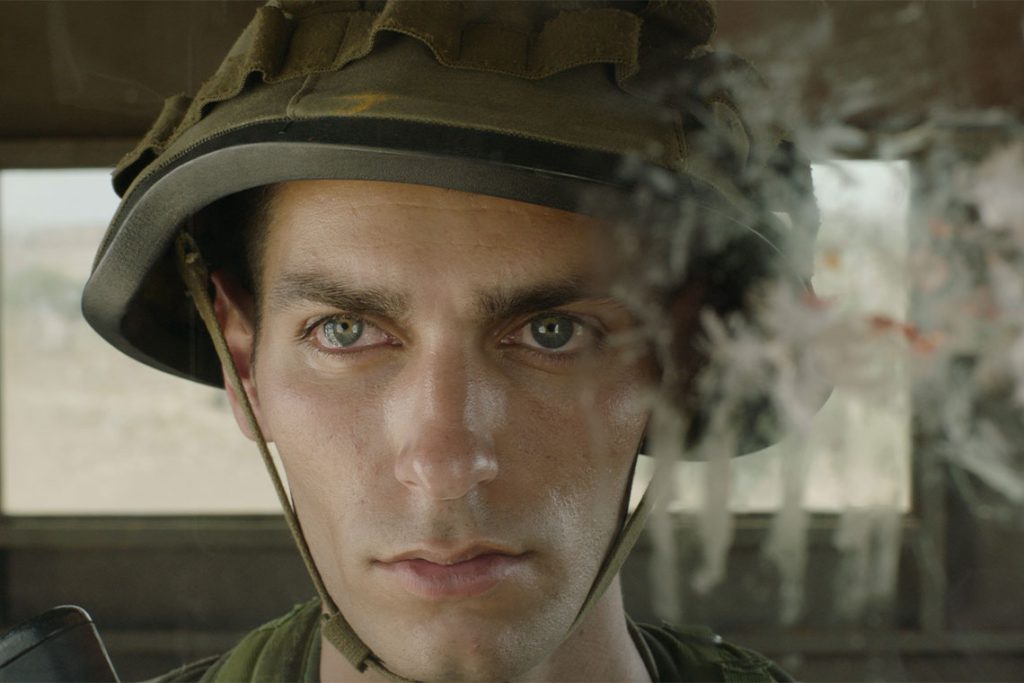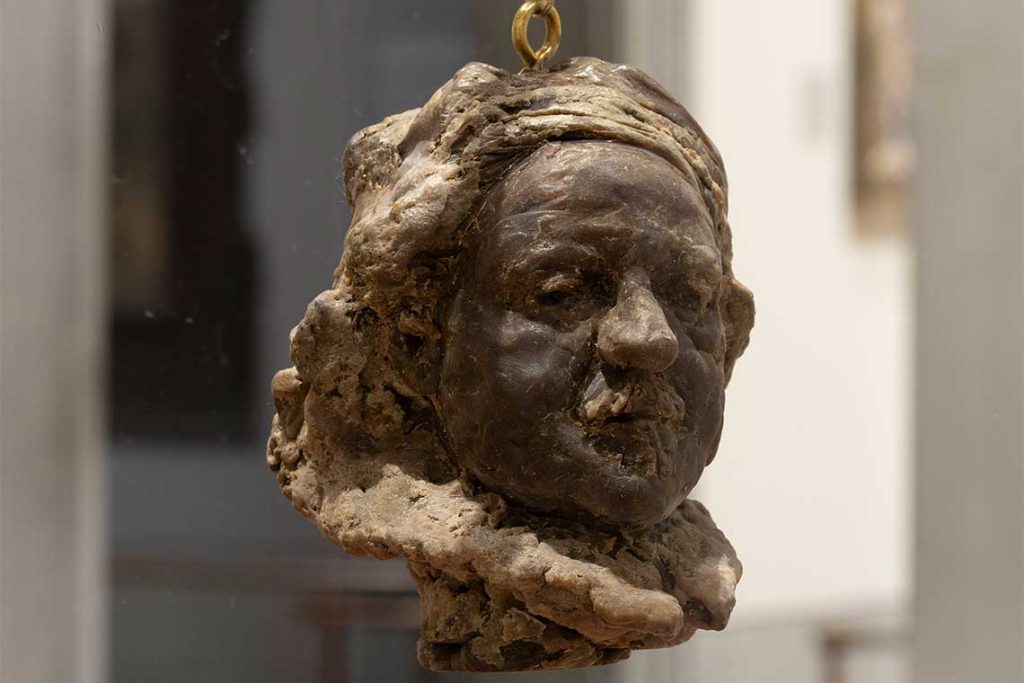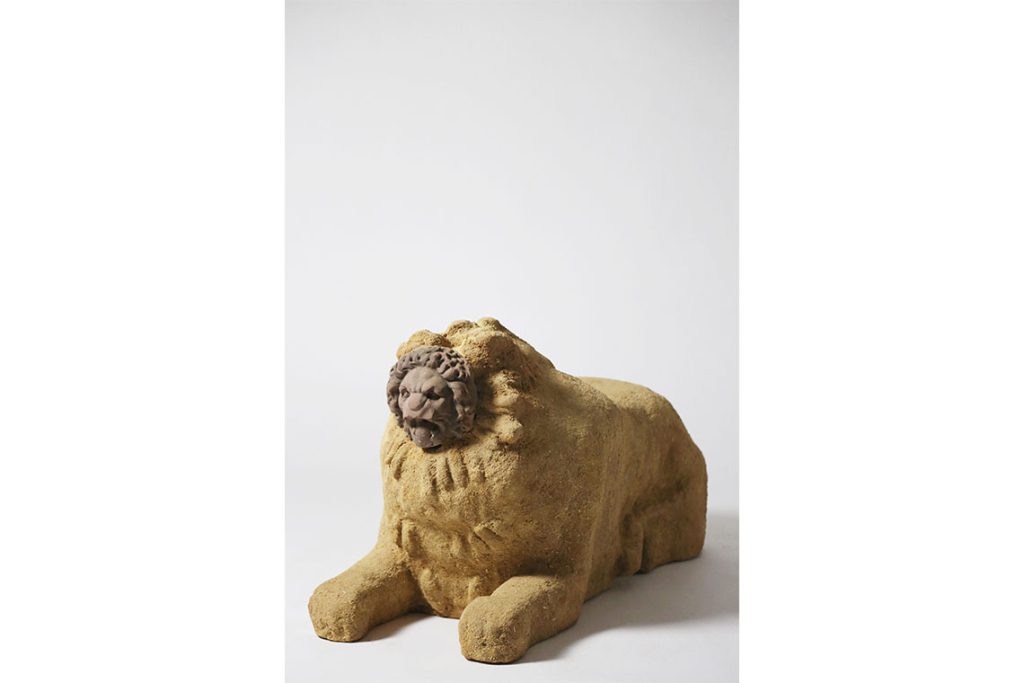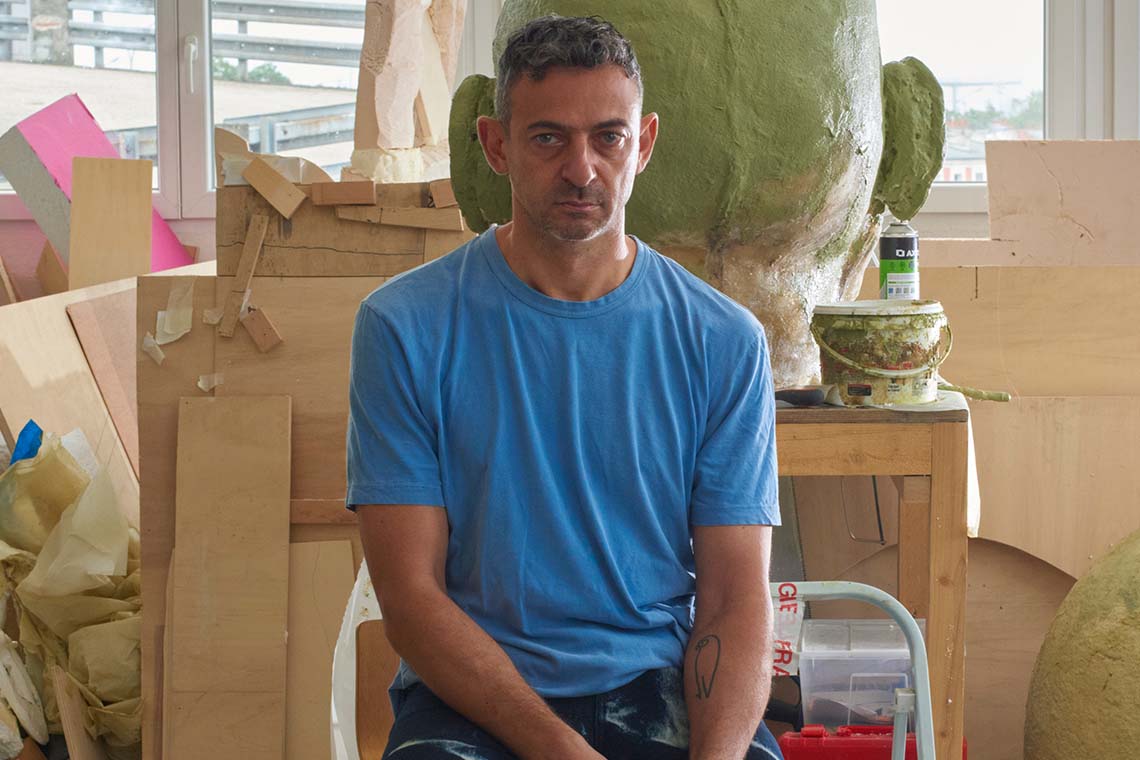Brutal truths and malleable textures blend in the artist’s multi-faceted work, where mythology, mud and trauma are alchemised.
Lebanese artist Ali Cherri has been meandering the infinite paths of the imagination. From his video Of Men and Gods and Mud (2022), which he exhibited at last year’s 59th Venice Biennale, The Milk of Dreams, to his sculptural assemblages, the imaginary’s flirt with reality shapes his practice in film, sculpture, installation and drawing. In this thinning border between the fictional and the actual, the artist builds portals to truths that are occasionally untold or largely shrouded.
“I work with imagination as a political strategy and tool for change,” Cherri explains from his studio in the northeastern Parisian suburb of Pantin. “The first thing authoritarian regimes do is to take hold of the space for the imaginary, so a world without them becomes unimaginable.” Against any restraint on imagination or remembering, he crafts work that stems from past realities and blossoms towards alternative futures. “To make a change in the world we live in, we must first be able to imagine a different one,” he affirms.
Folklore, tales and ethology, as well as the social and political atrocities of recent decades, are the sources visited by Cherri in his weaving of “other worlds”. In his three-channel 18-minute long Venice Biennale film, he synthesised a surreal story of a brick maker with the destructive impacts of the Merowe Dam in northern Sudan, where an estimated 50,000 local people were displaced during construction. Like Frankenstein’s creation of The Monster, the protagonist sculpts a monstrous creature from mud and pieces of scrap. The result of his nocturnal Sisyphean task symbolises the tragedies caused by the dam, from the loss of so many homes and livelihoods to the spread of waterborne diseases and the ecological impact on the water levels of the River Nile across the wider region.
After the video brought Cherri the Silver Lion Award for Promising Young Participant in Venice, its longer 84-minute version – titled Le Barrage (The Dam)(2022) – premiered as part of last year’s Cannes Film Festival. Whether through moving image or in sculpture, mud seeps into Cherri’s artistic curiosities. As a transformative texture and a reaction of soil blending into water, mud is both a binder and a delineator in his work. “The unity of earth and water is a materialisation of the imagination,” he explains. “From the first houses we built to the myths of Adam or Gilgamesh,” he adds, “mud has been the material for humanity to create homes, pots and creatures.” From archaeology to contemporary pottery, mud’s temporal language yields an inspirational entry point and provides a source material.

Cherri’s sculptural assemblages are mud figures arranged with objects he collects from antique shops and auction houses, occasionally in Paris or otherwise during his travels around the globe. “Objects of desire” he calls these findings, due to their “fluctuating” values based on market demand, and by exhibiting his sculptures at lauded institutions across the world, he restores a new life cycle for these once deaccessioned objects: “I think about how I can bring a Ming Dynasty statue or an Egyptian death mask from monetary value standards back to museums.” Surprise boxes full of archaeological fragments excite him for their unpredictability. “I have so many bits and pieces sitting at my studio,” he admits, “I just have to open the lids, and see how the contents will inspire me.” He works around his discoveries “quite intuitively” and, rather than focusing on their historical contexts, explores their material qualities instead. “Rather than paying attention to whether I am looking at a Roman or a pre-Colombian piece, I make decisions based on physical aspects, such as wood versus stone or how aged the surface is.”
Seated Figure, Standing Figure and Lion (all 2022), which Cherri exhibited at the 5th Kochi-Muziris Biennale,In Our Veins Flow Ink and Fire, are monstrous bodies. Part human and part relic, they are both spectral and robotic, their lazy bodies seemingly caught between motion and stillness, as static as social change but also kinetic like the speed of time. The bulbous silhouettes of the sculptures derive from mud’s piling nature: they have large limbs and fat torsos. Cherri contrasts their homogenous bodies with distinct visages — 151each mask hails from another auction house slot or an antique shop hunt. They travel from distinct geographies and places, including 500 BC Nigeria and 16th-century England. Their dramatic faces are occasionally angry, like a forgotten king, or deadpan as if they were sentenced to eternal silence. “I imagine two species coming together to create a new life,” he muses. “Such fragmented and destroyed forms are a way to understand our own ‘broken’ bodies and how we can gather for solidarity. There is strength in pain and in sticking together.”
After his solo exhibition If you prick us, do we not bleed?at London’s National Gallery last year, Cherri opens his first solo US show at New York’s Swiss Institute in September. Humble and quiet and soothing as mudis a mini survey of the artist’s recent work, organised by the institute’s director Stefanie Hessler and senior curator Alison Coplan. On the first floor, the installation of mud sculptures is dressed with a dancing light installation that veils the clay bodies with luminosity. The light activates the immediate reality of the mud and the found objects, but the luminosity also functions like a torch shone on the past. Upstairs, Of Men and Gods and Mud is this time on view for the American audience, extending the protagonist’s surreal daily practice with mud to another land of earth, water and ecological trauma.

Ali Cherri. Self Portrait at the Age of 63, after Rembrandt. 2022. Wax and metal frame. Wax head created by the artist and Andrew Lacey. Commissioned by the National Gallery, London as part of the 2021 National Gallery Artist in Residence programme.
Image courtesy of the National Gallery, London
In October, GAMeC in Bergamo, Italy will open Cherri’s largest museum exhibition to date and premiere a specially commissioned 151each mask hails from another auction house slot or an antique shop hunt. They travel from distinct geographies and places, including 500 BC Nigeria and 16th-century England. Their dramatic faces are occasionally angry, like a forgotten king, or deadpan as if they were sentenced to eternal silence. “I imagine two species coming together to create a new life,” he muses. “Such fragmented and destroyed forms are a way to understand our own ‘broken’ bodies and how we can gather for solidarity. There is strength in pain and in sticking together.”After his solo exhibition If you prick us, do we not bleed?at London’s National Gallery last year, Cherri opens his first solo US show at New York’s Swiss Institute in September. Humble and quiet and soothing as mudis a mini survey of the artist’s recent work, organised by the institute’s director Stefanie Hessler and senior curator Alison Coplan. On the first floor, the installation of mud sculptures is dressed with a dancing light installation that veils the clay bodies with luminosity. The light activates the immediate reality of the mud and the found objects, but the luminosity also functions like a torch shone on the past. Upstairs, Of Men and Gods and Mud is this time on view for the American audience, extending the protagonist’s surreal daily practice with mud to another land of earth, water and ecological trauma. In October, GAMeC in Bergamo, Italy will open Cherri’s largest museum exhibition to date and premiere a specially commissioned film, The Watchman (2023). Rekindling Of Men and Gods and Mud, this new production will chronicle a protagonist’s wanderings into the imaginary while committing to a humdrum daily task. A guard on the border between the Turkish Republic of Northern Cyprus and the Republic of Cyprus under Greek Cypriot rule muses about other worlds during his lazy shifts, as well as the dead cacti he sees around him. Disease-ridden, dead and dry thorny plants appear throughout the film’s sequences in large-scale drawings that the artist will debut during the show. “These dead cacti are like monsters, but they are also metaphors for rotten borders,” he says.

52 x 105 x 45 cm. Image courtesy of the artist and Galerie Imane Farès, Paris
As for the enduring significance of his birthplace, Cherri is unequivocal. “Beirut is my point zero, the place from which I think, even if I am not living there anymore,” he says about the city he left after university. “When I am in Sudan, Cyprus or elsewhere, the initial experience from which I understand a place is geared towards Beirut.” After the 2020 explosion, he finds it hard to “put my camera in my city, because the catastrophe remains too overwhelming to produce anything about it.” Initially, for example, he was planning to make a video project that takes place on the Lebanese-Syrian border, “but I should warm up with a short film about Cyprus,” he then decided. Until he finds himself ready for a work about his own land, he is out and about in other parts of the world to explore traumas that are somewhat familiar yet particular in the imaginations to which they take him.
This profile first appeared in Canvas 109: Smoke and Mirrors



